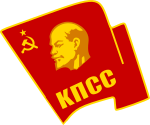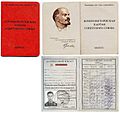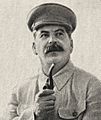Communist Party of the Soviet Union facts for kids
Quick facts for kids
Communist Party of the Soviet Union
Коммунистическая партия Советского Союза
|
|
|---|---|
 |
|
| Abbreviation | CPSU/KPSS |
| General Secretary | Yelena Stasova (first; Apr 1917–1918) Mikhail Gorbachev (last; Mar 1985–Aug 1991) |
| Founder | Vladimir Lenin |
| Founded | May 1917 |
| Dissolved | 29 August 1991 |
| Preceded by | Bolshevik faction of the RSDLP |
| Succeeded by | CPRF |
| Headquarters | Moscow, Staraya Square, 4 |
| Newspaper | Pravda |
| Youth wing | Young Communist League and Pioneers |
| Membership | 19 million (1986) |
| Ideology | Communism Marxism–Leninism (since 1929) |
| International affiliation | Second International (1912–14) Comintern (1919–43) Cominform (1947–56) |
| Colours | Red |
| Slogan | "Пролетарии всех стран, соединяйтесь!" ("Workers of the world, unite!") |
| Anthem |
("The Internationale") ("Hymn of the Bolshevik Party") (unofficial, 1939–52) |
The Communist Party of the Soviet Union (CPSU) was a very powerful political party in the Soviet Union. For a long time, it was the only legal party allowed to exist there. This meant it controlled almost everything in the country.
Before 1918, members of this party were part of a different group. They were a special part of the Russian Social Democratic Labour Party called the Bolsheviks. The first important leader of the CPSU was Vladimir Lenin. Later, Joseph Stalin became the first General Secretary of the party, serving from 1922 to 1952.
The party played a huge role in the 1917 October Revolution. This event overthrew the old government in Russia during World War I. The party changed its name a few times. From 1918 to 1925, it was called the Russian Communist Party. Then, from 1925 to 1952, it was known as the All-Union Communist Party. Finally, in 1952, it took the name Communist Party of the Soviet Union.
The Communist Party had full control over the government in the Soviet Union. It also supported communist groups in other parts of the world, like Eastern Europe, Asia, and Africa. In 1990, during a time of big changes called "perestroika" (which means "restructuring"), the party lost its special position. It was no longer the only party allowed. The CPSU officially ended in 1991. After that, it continued as the Communist Party of the Russian Federation. This new party has sometimes been the largest in the Russian parliament, called the State Duma.
Images for kids
-
Joseph Stalin, a powerful leader of the party from 1924 until his death in 1953.
-
The time when Leonid Brezhnev was leader is sometimes called the "Era of Stagnation."
-
Mikhail Gorbachev, the last leader of the CPSU and the Soviet Union, in 1986.
-
Stalinism refers to the ideas and policies of Joseph Stalin.
See also
 In Spanish: Partido Comunista de la Unión Soviética para niños
In Spanish: Partido Comunista de la Unión Soviética para niños







